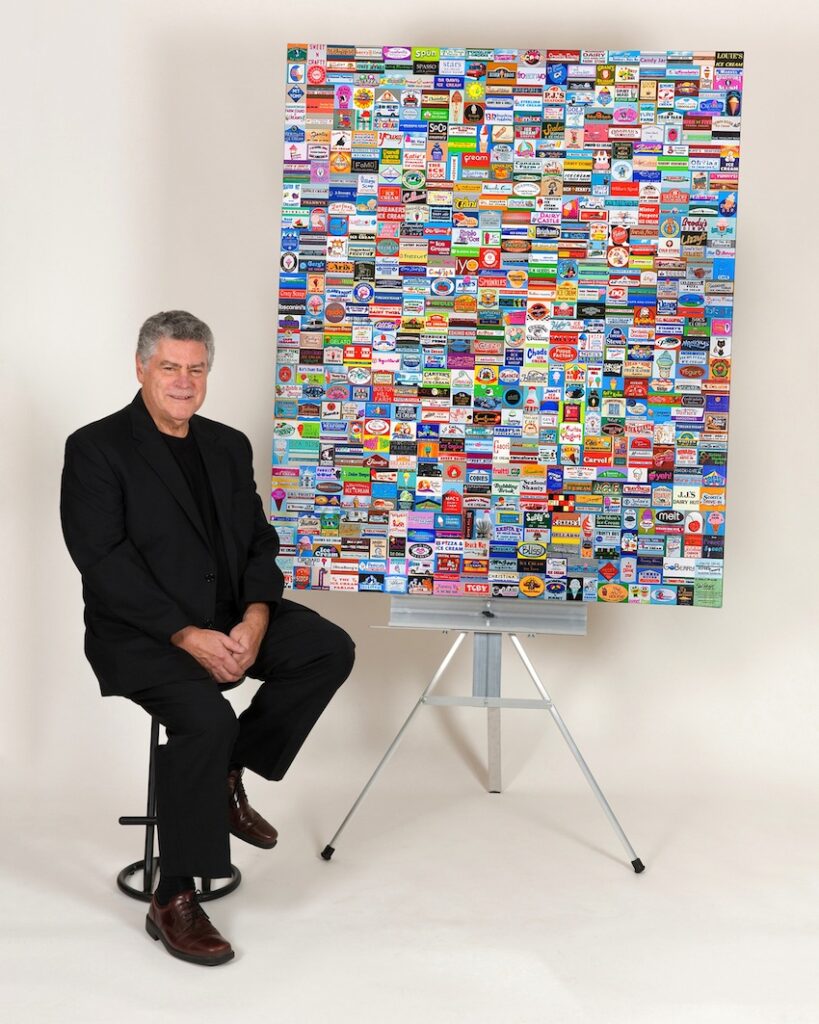
In 2013, Ed first introduced a 3-panel greater Boston restaurants montage. It contains more than 3,000 places, and historically preserves more than 1,500 restaurants which have closed or undergone name changes.
Comments which Ed has received or posted from different sources about History on Canvas montage include:
“Art is about communication and evoking response. You really hit it out of the park with this piece.”
“That is amazing. You certainly are doing something that really matters.”
“This takes me down memory lane in a way nothing else does!!!!”
“As Bob Hope said, “Thanks for the memories!”
Ed’s montages are included in the Scholars Archive@WJU digital repository at Johnson & Wales University. It allows the university community to share research and creative works across departments, colleges, campuses, and globally.
About Ed Sokoloff
Edward Sokoloff, age 81, was born, brought up, and resides in Boston. He is a lawyer by profession. His interest in photography began about 50 years ago.
On occasion Ed brought his camera along to a party, event or home visit, and took pictures. If he really liked a picture, he would send a print to the person in it. Some of these chance pictures have been prominently displayed in the homes of those people for 15, 20 or 25 years.
For more than ten years as a volunteer, Ed has taken pictures at an annual one-week all expenses paid summer camp for kids with special medical needs. His close-up pictures are easily identifiable among the thousands of pictures taken by others.
In the year 2000, Ed moved from the suburbs to Boston. Living in Copley Square, he began eating dinner out on most nights. He started taking pictures of the front of each restaurant at which he ate. Eventually he glued together the different restaurant pictures, which he hung in a frame on the wall of his apartment. Although he had favorite eating places, he began eating mostly at restaurants new to him. He bought a larger frame, added new pictures to the originals, and the size of the frame kept growing from there. Eventually, the pictures were cut down to just the restaurant name, instead of the full front of the building.
This enjoyable pastime became the seed for the idea to create a large montage of different greater Boston restaurants. As Ed got further into the project, the concept expanded from conventional restaurants to eating establishments at many different venues, including bookstores, drive-in movies, hospitals, libraries, museums, and even former jails, a correctional institution, and a former public bathroom building. Also included were a cafe operated by people with physical and/or developmental disabilities, and a pay-what-you-can-afford restaurant. Generally, places qualified as long as they had food facilities which are open to the public.
Other Massachusetts food-related montages now include Boston’s Chinatown, Boston’s North End, Boston Public Market, greater Boston food trucks, Martha’s Vineyard and Nantucket, and state-wide bagels, burgers, coffee, cupcakes, donuts, hot dogs, and ice cream. Also outside Massachusetts are Lincoln to Littleton NH and downtown Greenville SC montages.
Beginning in 2016, the montage concept expanded beyond food to History on Canvas, American Flags, Musical Instruments, Boston Area Catholic Churches, Charles River Boathouses, Friendly Scarecrows, and Nutcrackers/Snowmen, and state-wide Performing Arts Theatres and Bicycle Shops. New montages in process include state-wide breweries, cheeses, chocolates, breads, Irish pubs and tea rooms.
In San Francisco where the Marines Memorial Association’s Gold Star families’ annual event is held, Ed’s original American Flags montage is hung in the area of the Tribute Memorial Wall which contains the names of all military personnel lost in Iraq and Afghanistan since 9/11.
INSPIRATION
In all the montages which are limited to single subject categories, Ed has attempted to include as many as possible past and present places. His twofold purpose is to extend art to a new form of instant participant enjoyment in picking out familiar places, names, and objects on one canvas, which creates a means for viewers to enjoy the places that they know of now or grew up knowing and, to historically preserve all the places. Ed felt a sense of satisfaction when one person, after recognizing him, called him “historian”.